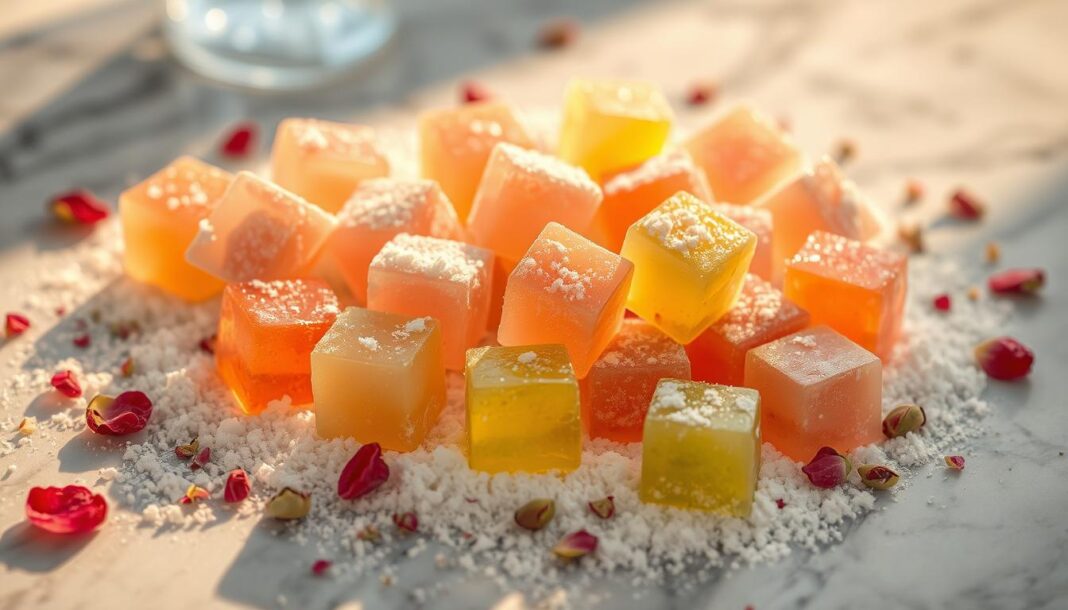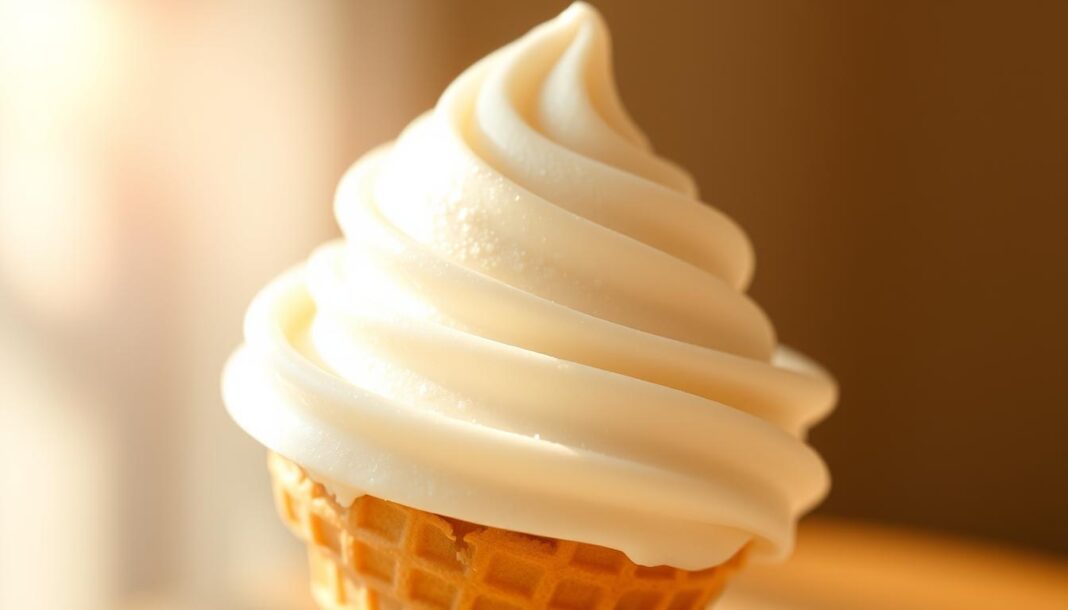In C.S. Lewis’s beloved Chronicles of Narnia, the White Witch tempts Edmund with a magical treat that has become an iconic symbol of the series: Turkish Delight. This enchanting candy has captivated readers and viewers for generations, leaving many to wonder about its origins and how to recreate it. At Historical Foods, we explore the history and cultural significance of this confection, as well as its role in the story.
We’ll take you on a culinary journey to uncover the magic behind this simple yet captivating candy. From understanding the science behind Turkish Delight to providing a step-by-step recipe for making it at home, our guide is designed to empower home cooks of all levels.
Key Takeaways
- Discover the historical and cultural context of Turkish Delight in the context of C.S. Lewis’s work.
- Learn the science behind making authentic Turkish Delight.
- Follow a simple recipe to create this iconic candy at home.
- Understand the significance of Turkish Delight in The Lion, the Witch and the Wardrobe.
- Explore the role of sugar and other ingredients in traditional Turkish Delight recipes.
The Enchanting World of Narnia Sweets
The enchanting world of Narnia sweets is not just a backdrop for the stories but a gateway to understanding the cultural and symbolic significance of food in the Chronicles of Narnia. As we explore this culinary journey, we find that C.S. Lewis masterfully wove food into the fabric of his narrative, creating a rich tapestry of cultural influences.
Turkish Delight: Edmund’s Temptation
Turkish Delight, a confection steeped in Middle Eastern tradition, plays a pivotal role in the Chronicles of Narnia, symbolizing temptation and moral choice. The White Witch’s enchanted Turkish Delight is a powerful symbol, representing the allure of easy pleasures and the danger of succumbing to temptation. This sweet treat is not just a fantasy creation but is rooted in real-world culinary traditions.
Interestingly, the use of sugar in such sweets is significant. In many cultures, including Moroccan traditions, the belief is that the more sugar used, the better the treat. For instance, a traditional Moroccan Tea recipe suggests using agave nectar, a natural sweetener that is beneficial for diabetic individuals and is absorbed into the bloodstream much slower than sugar.
The Cultural Significance Behind the Treats
We examine how C.S. Lewis used food throughout the Chronicles of Narnia to establish cultural differences between various regions and peoples. The significance of sharing meals in Narnia reflects Lewis’s understanding of food’s role in hospitality, community building, and cultural identity. Turkish Delight’s Middle Eastern origins connect to a broader pattern of Lewis incorporating elements from various world cultures and mythologies into his fantasy world.
The contrast between wholesome foods associated with Aslan and his followers versus the artificially tempting treats of the White Witch establishes a moral dimension to food choices in the Narnia universe. Recipes from the Narnia universe have been adapted and preserved by fans, including the publication of official Narnia cookbooks that help readers experience the stories through taste.
Understanding Turkish Delight: The Star of Narnia Sweets
As a key element in Narnia’s magical world, Turkish Delight, also known as Lokum, has become a beloved treat globally. This confectionery delight has captured the hearts of many, not just for its enchanting taste but also for its rich history and cultural significance.
What is Lokum?
Lokum, or Turkish Delight, is a traditional confectionery made from a mixture of sugar, water, and cornstarch, often flavored with rosewater, lemon, or other natural extracts. The use of cornstarch is crucial as it gives Turkish Delight its characteristic gel-like texture. We emphasize the importance of using natural flavorings, as synthetic ones can result in an unpleasant taste. The final product is typically dusted with powdered sugar to prevent sticking.
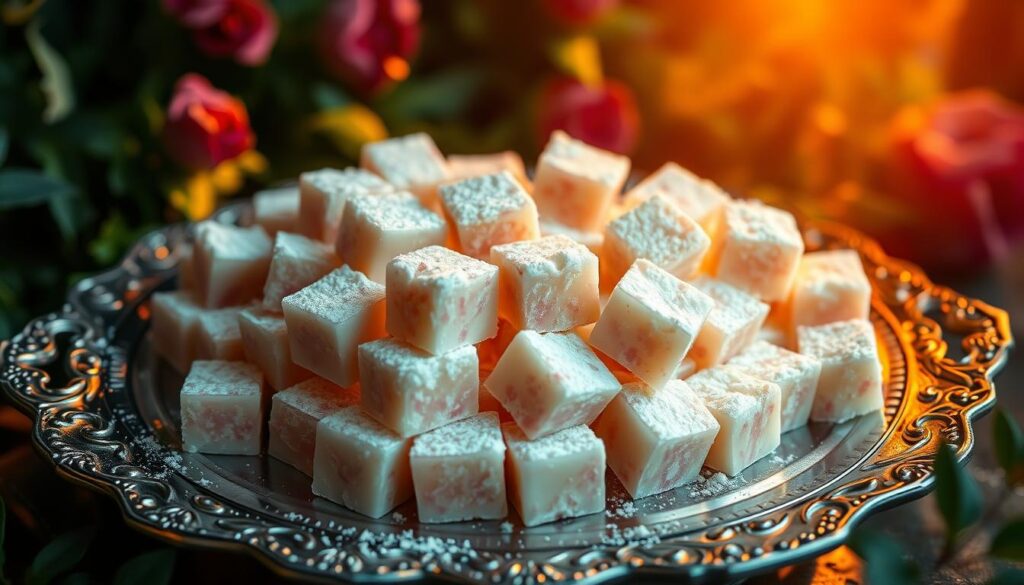
Traditional Flavors and Variations
Traditional Turkish Delight comes in a variety of flavors, with rosewater being the most classic and recognizable, likely inspiring C.S. Lewis’s description in the Narnia chronicles. Beyond rose, authentic Lokum is made with numerous flavors including lemon, orange blossom, mint, and bergamot, each offering a different sensory experience. The visual appeal is often enhanced with natural colorings, creating jewel-toned treats. Many recipes also incorporate nuts like pistachios or hazelnuts, though the Narnia version appears to be the simpler, nut-free variety.
For more on making Turkish Delight inspired by Narnia, visit our detailed guide on The Lion, the Witch, and the Wardrobe Turkish.
Essential Ingredients and Equipment
Before you start making your own Turkish Delight, it’s essential to understand the basic components and tools required for this traditional confectionery. Making Turkish Delight is not just about following a recipe; it’s about understanding the role of each ingredient and the importance of the right equipment.
The Basic Components
The fundamental ingredients in Turkish Delight include water, sugar, and cornstarch. The mixture of these ingredients, when cooked to the right temperature, creates the signature gel-like texture of Turkish Delight. Water is used to dissolve the sugar and cornstarch, creating a syrup. Cornstarch is crucial as it helps in thickening the mixture, giving Turkish Delight its characteristic texture. Sugar adds sweetness and helps in achieving the right consistency when heated to a specific temperature.
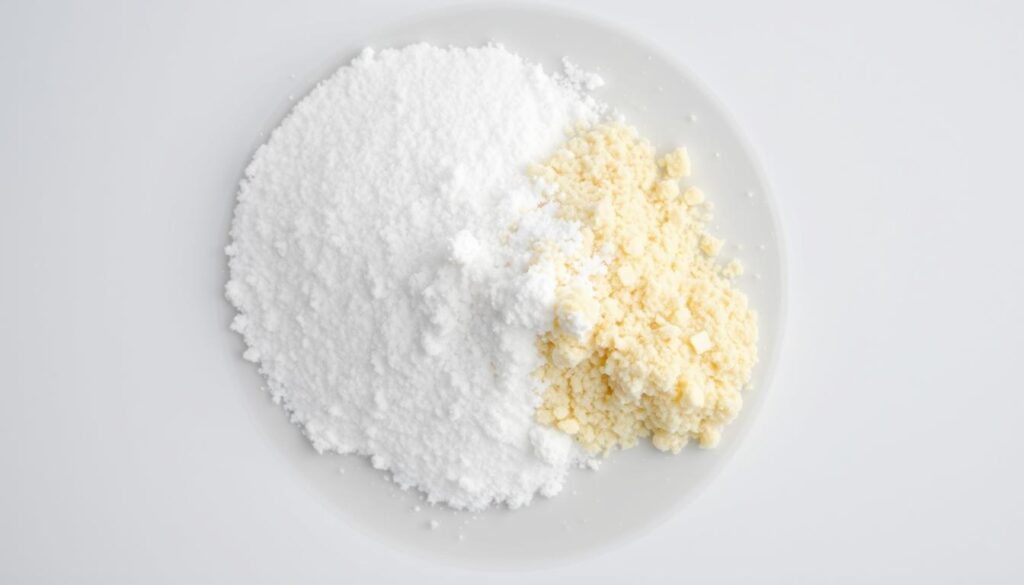
Tools You’ll Need for Success
To make Turkish Delight successfully, you’ll need a few essential tools. A candy thermometer is crucial for achieving the precise soft ball stage (250°F) that determines the final texture of your Turkish Delight. A heavy-bottomed pot or Dutch oven is necessary for even heat distribution, preventing hot spots that could cause scorching or uneven cooking of the sugar mixture. Additionally, silicone or heat-resistant spatulas and whisks are your best tools for continuous stirring without scratching your cookware or introducing unwanted air bubbles into the mixture.
A 9×9 inch baking dish lined with parchment paper and lightly oiled is ideal for setting your Turkish Delight, allowing for easy removal and cutting once set. Measuring tools, including a digital scale for precise ingredient measurements and a set of measuring cups and spoons, will ensure you maintain the critical ratio of water to cornstarch to sugar.

Step-by-Step Guide to Making Narnia Sweets
Now that we’ve explored the enchanting world of Narnia sweets, it’s time to dive into the process of making these delightful treats. Crafting Turkish Delight is an art that requires precision, patience, and a bit of creativity.
Preparing the Sugar Syrup
To start, we need to prepare the sugar syrup, a crucial component of our Turkish Delight. This involves combining granulated sugar, water, and a touch of cream of tartar in a saucepan. Heating this mixture to the precise temperature is essential for achieving the right consistency. We recommend using a candy thermometer to ensure accuracy.
The syrup is ready when it reaches the desired temperature. At this point, we carefully remove it from the heat source, taking care not to let it boil over.
Creating the Perfect Cornstarch Slurry
While the sugar syrup is being prepared, we can start making the cornstarch slurry. This involves mixing cornstarch with water until it’s smooth and free of lumps. The slurry is then heated until it thickens, creating a smooth, gel-like texture that’s essential for our Turkish Delight.
Combining and Cooking the Mixture
With both the sugar syrup and cornstarch slurry ready, we can now combine them. This mixture is then cooked until it reaches the desired consistency. It’s crucial to stir constantly during this process to prevent lumps from forming and to achieve a uniform texture.
Setting and Cutting Your Turkish Delight
Get your prepared dish ready—a 9×9 inch pan lined with parchment and lightly oiled. Pour in the lokum and spread it evenly. Now, patience is key again: let it set at room temperature for 5-10 hours. Do not rush to the fridge! The lokum sets best at room temperature. After waiting, the fun part begins. Flip the lokum onto a cornstarch-dusted cutting board, peel off the parchment, and dust the top with more cornstarch. Cut into bite-sized pieces. Over in a separate dish filled with powdered sugar, dredge each piece until they’re coated like snowy Narnia.
| Step | Description | Time |
|---|---|---|
| Preparing Sugar Syrup | Combine sugar, water, and cream of tartar, and heat to precise temperature. | 15 minutes |
| Creating Cornstarch Slurry | Mix cornstarch with water, heat until thickened. | 10 minutes |
| Combining and Cooking | Combine syrup and slurry, cook until desired consistency. | 20 minutes |
| Setting and Cutting | Pour into prepared pan, let set, then cut into pieces. | 5-10 hours |
Store the Turkish Delight in an airtight container filled with a 2:1 ratio of powdered sugar to cornstarch. This will keep them from sticking together and maintain that classic coating. And remember, these treats are best eaten fresh—enjoy within 72 hours! With time and practice, you’ll master the art of making these delightful Narnia sweets.

Troubleshooting Common Challenges
Achieving the ideal Turkish Delight requires overcoming several common obstacles that can arise during its preparation. With a bit of patience and understanding of the process, you can successfully navigate these challenges.
Why Didn’t My Turkish Delight Set Properly?
If your Turkish Delight didn’t set as expected, it could be due to incorrect temperature or insufficient cooking time. Ensuring that your sugar syrup reaches the correct temperature is crucial. Additionally, not cooking the cornstarch mixture long enough can prevent it from setting properly.
Dealing with Lumps and Texture Issues
Lumps in your Turkish Delight can be a result of inadequate mixing of the cornstarch slurry or not cooking it sufficiently. To avoid this, make sure to mix the slurry thoroughly before adding it to the sugar syrup, and cook it until it reaches a smooth consistency.
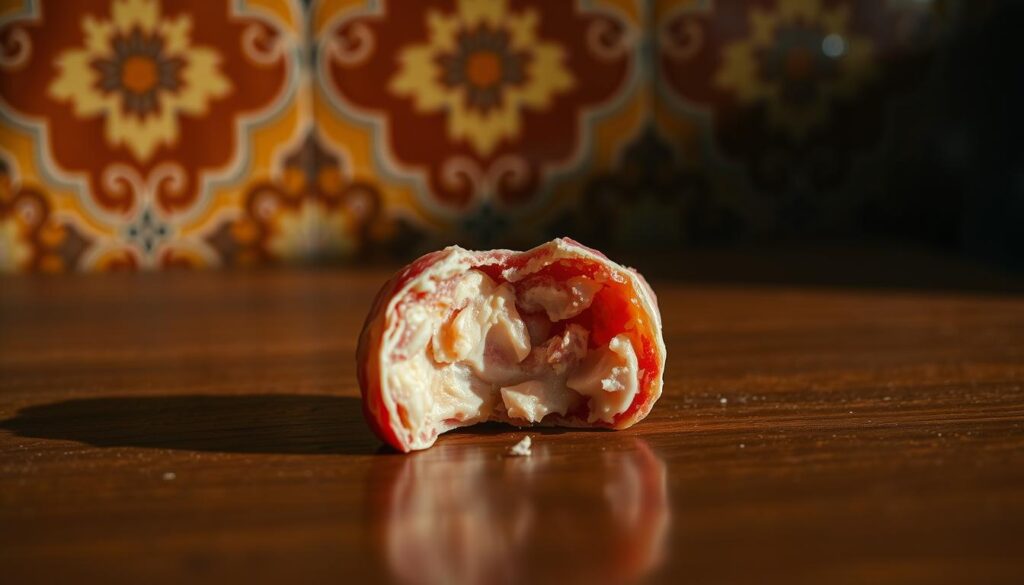
Storage Solutions for Perfect Results
Proper storage is key to maintaining the quality of your Turkish Delight. Store the pieces in an airtight container filled with a 2:1 ratio of powdered sugar to cornstarch. This will prevent them from sticking together. For the best results, enjoy your Turkish Delight within 72 hours.
| Storage Method | Ratio | Shelf Life |
|---|---|---|
| Airtight Container | 2:1 (powdered sugar:cornstarch) | Up to 72 hours |
| Powdered Sugar Bath | Generous coating | Extended freshness |
For more detailed recipes and guides, visit our page on Turkish Delight Narnia Recipe.
Beyond Turkish Delight: Other Magical Narnia-Inspired Treats
As we conclude our culinary journey through Narnia, we discover that Turkish Delight is just the beginning of the magical treats that await us. The Chronicles of Narnia are filled with an array of delightful recipes that transport us to a world of fantasy and wonder.
One such treat is Mr. Tumnus’s hot chocolate, made by allowing rich, dark chocolate to permeate through steaming cold water or milk, creating a deep, velvety flavor. Another is Lucy’s roasted apples, where a little bit of cinnamon, honey, and lemon juice are added to the core before baking to perfection.
These traditional British foods, featured throughout the series, not only reflect C.S. Lewis’s cultural background but also the simplicity and heartiness of wartime cuisine. By adapting these recipes to modern dietary needs, we can continue to experience the magic of Narnia in our own kitchens.
For those eager to explore further, resources like the official Narnia Cookbook and fan-created recipe collections offer a wealth of inspiration. As we savor these treats, we’re reminded of the themes of hospitality and communal dining that run throughout the series, from the Beavers’ humble dinner to the grand feasts at Cair Paravel.

